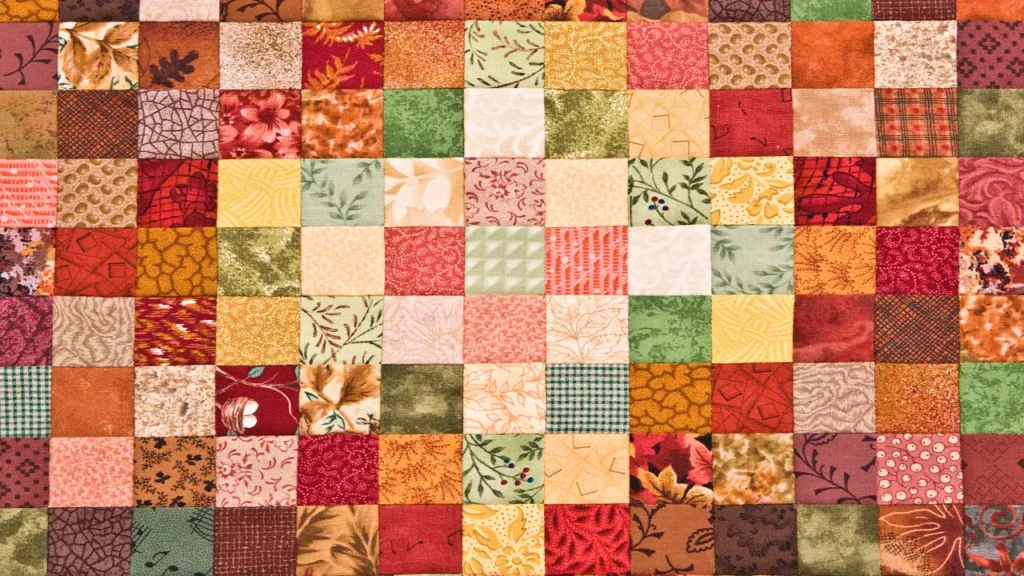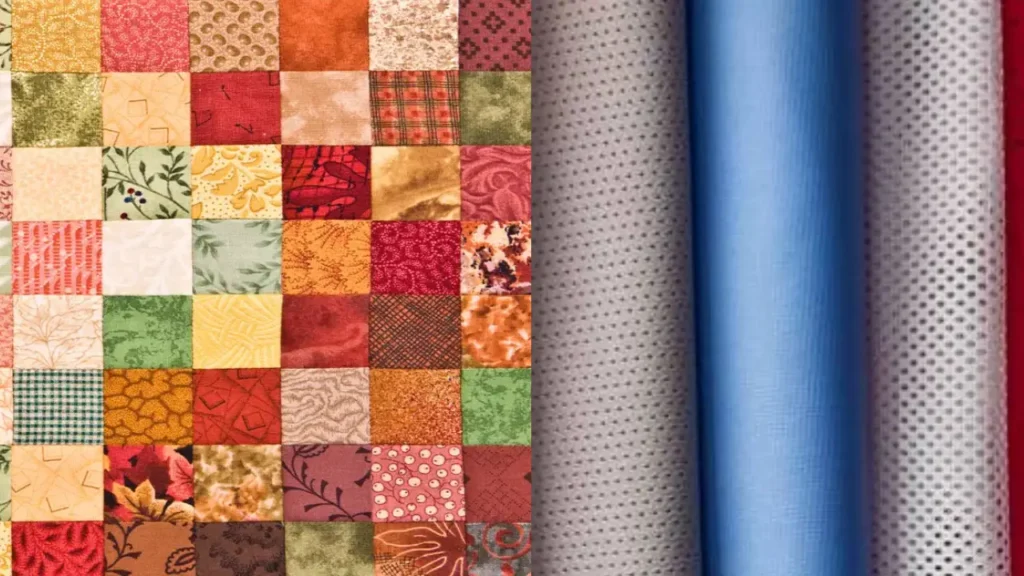Embarking on a sewing project, whether for a cozy blanket or a stylish garment, often begins with a fundamental choice: what kind of textile to use? While “fabric” is a broad term for woven or knitted materials, a “quilt” is a finished product – a layered textile assembly.
This distinction is crucial, as the characteristics of fabric specifically designed for quilting differ significantly from those intended for other uses. Understanding these differences will guide you in selecting the perfect materials for your next creative endeavor.
What is Quilt?

A quilt is a multi-layered textile, traditionally composed of three distinct layers: a decorative top, a middle layer of batting (or wadding) for insulation and loft, and a backing fabric. These layers are held together by a process called quilting, which involves stitching through all three layers in various patterns, not only to secure them but often to add to the aesthetic design.
While historically used primarily as bed coverings for warmth, modern quilts are also created as artistic expressions, wall hangings, and decorative pieces, showcasing intricate designs, patchwork, appliqué, and diverse fabric choices.
What is Fabric?

Fabric, in its most common understanding, refers to any flexible material made from interlacing fibers or yarns, typically through processes like weaving, knitting, or felting. These fibers can be natural, such as cotton, wool, silk, or linen, or synthetic, like polyester, nylon, or rayon, or even blends of different types.
The specific way these fibers are constructed, along with their composition, determines the fabric’s characteristics, including its texture, drape, strength, breathability, and suitability for various applications, ranging from clothing and upholstery to industrial uses.
Quilt vs Fabric

While often used interchangeably by beginners, “quilt” and “fabric” refer to distinctly different things in the textile world. One is a finished product, the other is the raw material. Understanding their specific definitions and characteristics is crucial for any sewing or crafting enthusiast.
This guide will break down the fundamental differences between a quilt and fabric, particularly focusing on the specialized nature of quilting fabric.
Definition
Quilt is a layered textile product, traditionally made from three components: a pieced or solid fabric top, a middle layer of batting, and a backing fabric. These layers are joined together through a process of stitching, known as quilting, which can be purely functional or highly decorative. The finished quilt serves a purpose, commonly as a bed covering, wall hanging, or decorative item.
Fabric, on the other hand, is the base material from which textiles are made. It’s a broad term encompassing any cloth produced by weaving, knitting, or otherwise interlacing fibers or yarns. Fabric comes in rolls or by the yard and is the raw material used to create quilts, garments, upholstery, and countless other finished goods.
Purpose
The primary purpose of a quilt is to provide warmth, comfort, and often artistic expression. Its multi-layered structure is designed to trap air, offering insulation, while the stitched patterns add structural integrity and visual appeal. Quilts are made to be used, displayed, and cherished as completed articles.
The purpose of fabric is to serve as the fundamental component for creating other items. Its purpose is to be cut, sewn, draped, or manipulated to form a vast array of products. Different fabrics are designed with specific end uses in mind, dictating their weave, fiber content, and finish.
Structure
A quilt possesses a composite, three-dimensional structure. It is an assembly of distinct layers – the quilt top (often made from many smaller fabric pieces), the batting, and the backing – bound together by stitching. This layered construction is what defines it as a quilt.
Fabric has a two-dimensional structure, being a continuous sheet of interwoven or interlooped threads. It is a single, unlayered piece of material, varying in thickness and density based on its construction and fiber content.
Production Process
Quilts are created through a multi-step artisanal process that involves design, fabric selection, cutting, piecing (sewing smaller fabric pieces together to form the top), layering with batting and backing, and finally, the quilting stitch that secures all layers. This process culminates in a finished good.
Fabric is produced through industrial manufacturing processes. This includes spinning raw fibers into yarn, followed by weaving (interlacing two sets of yarns at right angles), knitting (interlooping a single yarn), or other methods like felting, to create the continuous sheet of material.
Material Consumption
A quilt consumes fabric. Its creation requires various types of fabric for the top, batting (though not always fabric in the traditional sense, it’s a textile material), and the backing. The finished quilt represents the transformation of raw fabric into a completed, functional or artistic piece.
Fabric is the material that is consumed. It is the starting point for countless textile projects. Without fabric, quilts, clothes, curtains, and many other items could not be made.
Here are the differences between quilt and fabric:
| Aspect | Quilt | Fabric |
| Definition | Multi-layered textile product | Raw material, woven/knitted sheet of fibers |
| Purpose | Warmth, comfort, art, finished item | Base for creating other items |
| Structure | Three-dimensional, layered assembly | Two-dimensional, single sheet |
| Production | Handcrafted/machine-stitched assembly | Industrial weaving/knitting/felting |
| Role in Project | The finished product | The raw material consumed |
How to Choose Quilt and Fabric
Choosing the right quilt – whether purchasing one or selecting a pattern to make – involves considering its intended use, design aesthetics, and the quality of its construction. For a ready-made quilt, assess the stitching density, the feel of the batting, and the integrity of the seams to ensure durability and comfort. Consider how its colors and patterns will complement your existing decor or fulfill its purpose, such as a cozy bedspread or a decorative wall hanging.
When selecting fabrics for a quilting project, the choices are paramount for the final outcome. Focus on the fiber content, which for quilting is almost exclusively 100% cotton due to its stability and ease of use. Evaluate the thread count and weave, aiming for a tight, dense construction that resists fraying and allows for precise cutting. Pay attention to colorfastness and print quality, ensuring the dyes won’t bleed and the patterns are crisp and clear after washing, preserving your quilt’s beauty for years.
Here are key aspects to consider when choosing:
Width: Standard quilting fabric is 44/45 inches wide. Knowing this helps in calculating yardage needed for quilt patterns, optimizing fabric usage and minimizing waste during cutting.
Intended Use of the Quilt:
- For a finished quilt: Decide if it’s for warmth (e.g., bed quilt), decoration (e.g., wall hanging), or a specific recipient. This dictates size, weight, and aesthetic.
- For fabric selection: Consider if the quilt will be frequently washed (e.g., baby quilt) or is purely decorative. This influences fabric durability and washability.
Design and Aesthetics:
- For a finished quilt: Look for patterns, colors, and quilting motifs that appeal to your personal style and complement the room or recipient. Ensure the overall design flows well.
- For fabric selection: Plan your color palette and print scale carefully. Mix large, medium, and small prints, along with solids, to create visual interest and balance in your quilt design.
Fabric Quality (for quilting projects):
- Fiber Content: Opt for 100% quilting cotton, renowned for its stability, breathability, and ease of handling during cutting and stitching. Avoid stretch fabrics or those with loose weaves for piecing.
- Thread Count & Weave: A higher thread count (60-75 threads/inch) and tight weave indicate good quality fabric. This density minimizes fraying, ensures crisp seams, and helps the fabric hold its shape accurately.
- Colorfastness & Print Quality: Test for colorfastness by rubbing a damp white cloth on a small inconspicuous area. Check that prints are sharp, on-grain, and consistent, without blurring or misprints, which can distort your finished blocks.
- Hand (Feel): High-quality quilting cotton feels soft, smooth, and substantial. Avoid fabrics that feel stiff, thin, or brittle, as these can be difficult to work with and may not hold up over time.
Is Quilt the Same as Fabric?
No, a quilt is not the same as fabric. Fabric is the raw material, a two-dimensional sheet of interwoven or interlooped fibers, available by the yard, used to create countless items.
A quilt, on the other hand, is a finished, multi-layered textile product, typically consisting of a decorative top, batting, and a backing, all stitched together. While fabric is essential for making a quilt, the quilt itself is a completed item resulting from a specific creative process that transforms fabric into a functional or artistic piece.
Are Quilt and Fabric Compatible?
Absolutely, quilt and fabric are inherently compatible – in fact, fabric is the fundamental building block of a quilt! Quilts are constructed from fabric. Different types of fabrics are chosen for a quilt’s top, batting, and backing, with quilting-specific fabrics being particularly well-suited due to their stable weave and high quality, ensuring the quilt’s durability and aesthetic appeal.
Yes, “quilt” and “fabric” are fundamentally compatible, as fabric is the primary material used to create a quilt. Quilting involves taking various fabrics, often specifically designed for quilting, and transforming them through cutting, piecing, and stitching into a finished, layered textile. The compatibility lies in the fabric serving as the essential building block for the quilt.
What is the Difference Between Quilt and Cotton?
“Quilt” refers to a finished, layered textile product, like a blanket or wall hanging, made from multiple pieces of fabric stitched together with batting in between.
“Cotton,” on the other hand, is a natural fiber derived from the cotton plant, which is then spun into yarn and woven into fabric. Therefore, cotton is a type of material, and specifically, 100% cotton fabric is the most common type of fabric used to construct quilts.
Conclusion
Understanding the inherent differences between quilting fabric and general fabric is key to successful sewing. Quilting fabrics are specifically milled for durability, precise cutting, and vibrant, lasting colors, making them ideal for patchwork and intricate designs.
While all quilts use fabric, not all fabrics are suitable for quilting. The tighter weave and consistent quality of dedicated quilting fabric ensure your finished quilt is not only beautiful but also resilient through years of love and use.
For your next quilting masterpiece, consider exploring wholesale quilting fabric from Fanda Fabrics, a reliable source for high-quality materials to bring your creative visions to life.
